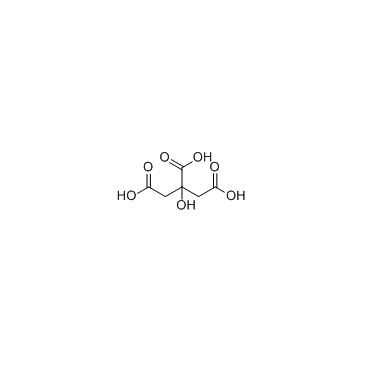Ammonium citrate tribasic

Ammonium citrate tribasic structure
|
Common Name | Ammonium citrate tribasic | ||
|---|---|---|---|---|
| CAS Number | 3458-72-8 | Molecular Weight | 243.215 | |
| Density | 1.22 g/mL at 20 °C | Boiling Point | 100 °C(lit.) | |
| Molecular Formula | C6H17N3O7 | Melting Point | 185 °C (dec.)(lit.) | |
| MSDS | Chinese USA | Flash Point | 155.2ºC | |
| Symbol |

GHS07 |
Signal Word | Warning | |
Use of Ammonium citrate tribasicCitric acid triammonium (Triammonium citrate) is formed by Citric acid (HY-N1428) reacting with ammonia in a molar ratio of 1:3. Citric acid triammonium can be used as the carbon source to prepare carbon quantum dots (CDs). Citric acid triammonium with higher nitrogen components might promote the nitrogen-based functional groups in CDs, leading to a more efficient emission-color tunability[1][2]. |
| Name | triammonium citrate |
|---|---|
| Synonym | More Synonyms |
| Description | Citric acid triammonium (Triammonium citrate) is formed by Citric acid (HY-N1428) reacting with ammonia in a molar ratio of 1:3. Citric acid triammonium can be used as the carbon source to prepare carbon quantum dots (CDs). Citric acid triammonium with higher nitrogen components might promote the nitrogen-based functional groups in CDs, leading to a more efficient emission-color tunability[1][2]. |
|---|---|
| Related Catalog | |
| Target |
Human Endogenous Metabolite |
| References |
| Density | 1.22 g/mL at 20 °C |
|---|---|
| Boiling Point | 100 °C(lit.) |
| Melting Point | 185 °C (dec.)(lit.) |
| Molecular Formula | C6H17N3O7 |
| Molecular Weight | 243.215 |
| Flash Point | 155.2ºC |
| Exact Mass | 243.106644 |
| PSA | 141.85000 |
| Vapour density | 1.8 (vs air) |
| Index of Refraction | 1.583 |
| Stability | Stable. Incompatible with strong oxidizing agents. |
| Water Solubility | H2O: 1 M at 20 °C, clear, colorless |
| Symbol |

GHS07 |
|---|---|
| Signal Word | Warning |
| Hazard Statements | H315-H319-H335 |
| Precautionary Statements | P261-P305 + P351 + P338 |
| Personal Protective Equipment | dust mask type N95 (US);Eyeshields;Gloves |
| Hazard Codes | Xi:Irritant |
| Risk Phrases | R36/37/38 |
| Safety Phrases | S26-S36 |
| RIDADR | NONH for all modes of transport |
| WGK Germany | 3 |
| RTECS | GE7545000 |
|
~% 
Ammonium citrat... CAS#:3458-72-8 |
| Literature: Journal of the American Chemical Society, , vol. 37, p. 211 |
| Precursor 1 | |
|---|---|
| DownStream 0 | |
|
L-lactate production from biodiesel-derived crude glycerol by metabolically engineered Enterococcus faecalis: cytotoxic evaluation of biodiesel waste and development of a glycerol-inducible gene expression system.
Appl. Environ. Microbiol. 81(6) , 2082-9, (2015) Biodiesel waste is a by-product of the biodiesel production process that contains a large amount of crude glycerol. To reuse the crude glycerol, a novel bioconversion process using Enterococcus faecal... |
|
|
Enzymatic saccharification and bioethanol production from Cynara cardunculus pretreated by steam explosion.
Bioresour. Technol. 186 , 309-15, (2015) The correct choice of the specific lignocellulosic biomass pretreatment allows obtaining high biomass conversions for biorefinery implementations and cellulosic bioethanol production from renewable re... |
|
|
Binding to serine 65-phosphorylated ubiquitin primes Parkin for optimal PINK1-dependent phosphorylation and activation.
EMBO Rep. 16 , 939-54, (2015) Mutations in the mitochondrial protein kinase PINK1 are associated with autosomal recessive Parkinson disease (PD). We and other groups have reported that PINK1 activates Parkin E3 ligase activity bot... |
| 1,2,3-Propanetricarboxylic acid, 2-hydroxy-, triammonium salt |
| CITRIC ACID DIAMMONIUM SALT |
| 2-Hydroxy-1,2,3-propanetricarboxylic acid triammonium salt |
| Triammonium citrate 99-1 |
| Tri-AmmoniumCitrateGr |
| AMMONIUM HYDROGENCITRATE |
| Ammonium citrate tribasic |
| 2-Hydroxy-1,2,3-prop |
| MFCD00013068 |
| Citric acid triammonium salt |
| tri-ammonium citrate |
| citric acid,triammonium compound |
| Tri-Ammoniumcitrat |
| CITRIC ACID,DIAMMONIUM |
| Tri-AmmoniumCitrateExtraPure |
| ammonium citrate |
| Citronensaeure,Triammonium-Verbindung |
| Triammonium citrate |
| Citric Acid,Triammonium Salt |
| EINECS 222-394-5 |


